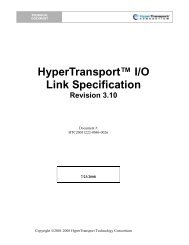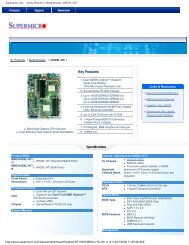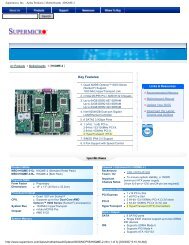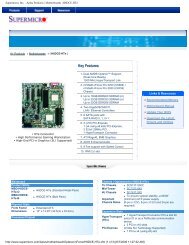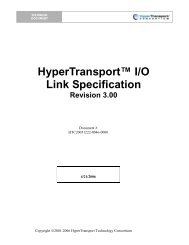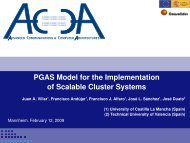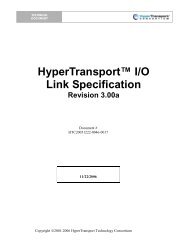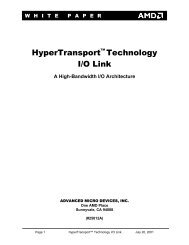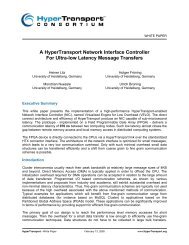RCHTX-XV4 High Performance Computing (HPC) Application ...
RCHTX-XV4 High Performance Computing (HPC) Application ...
RCHTX-XV4 High Performance Computing (HPC) Application ...
You also want an ePaper? Increase the reach of your titles
YUMPU automatically turns print PDFs into web optimized ePapers that Google loves.
<strong>RCHTX</strong>-<strong>XV4</strong>Datasheet<strong>High</strong> <strong>Performance</strong> <strong>Computing</strong> (<strong>HPC</strong>) <strong>Application</strong> Acceleration BoardMajor Functionality:The <strong>RCHTX</strong> high performance computing (<strong>HPC</strong>) board provides a complete platform for FPGAbasedacceleration of software algorithms for a variety of computing applications• Xilinx Virtex-4 FPGA for <strong>Application</strong>Acceleration- XC4VLX160 or XC4VSX55 device- Custom hardware co-processing for AMDOpteron systems- Fully programmable from Celoxicasoftware compilation tools• <strong>High</strong> Speed HTX Interface- Data transfer up to 3.2GB/s- Direct access to entire host systemmemory space- Kernel FPGA manages I/O tasks and freesuser FPGA for co-processing- HTX form factor• Dedicated Memory- 24MB QDR SRAM on board- 9.6 GB/sec max transfer ratesProduct OverviewFPGA based hardware acceleration can provide dramatic performance improvements for the compute intensive algorithms frequentlyused in industries such as:• Oil and Gas• Finance• Medical Imaging• Life SciencesUntil now, the application of FPGA hardware to these problems has been hampered by poor communications bandwidth betweenthe host system and the FPGA and by the size and capability of the FPGA devices available. The architecture of the board solutionsavailable also required application developers to become involved in non-application areas such as I/O drivers.The <strong>RCHTX</strong> <strong>HPC</strong> board provides solutions to these problems:• The HTX interface to the host system offers a potential communications bandwidth of 3.2 GBytes/s.• HTX provides direct access to the entire host system memory space.• <strong>RCHTX</strong> uses Xilinx Virtex-4 FPGAs offering high gate count, advanced dedicated arithmetic units and high clock speeds.• The <strong>RCHTX</strong> architecture insulates the application developer from I/O and driver issues by using a kernel FPGA to interface to thehost system and to provide control and management of data streaming between the host processor and the on-board memories.When these features are coupled with Celoxica C-to-FPGA software compilation technology, the <strong>RCHTX</strong> becomes an ideal platform foraccelerated computing development and solution deployment.www.celoxica.com
<strong>RCHTX</strong>-<strong>XV4</strong><strong>High</strong> <strong>Performance</strong> <strong>Computing</strong> (<strong>HPC</strong>) <strong>Application</strong> Acceleration Board<strong>RCHTX</strong> FunctionalityThe <strong>RCHTX</strong> <strong>HPC</strong> board provides the following functionality:• User FPGA:- Xilinx Virtex-4 XC4VLX160 or XC4VSX55 FPGA- 4 banks 2M * 16 QDR SRAM- VGA/DVI video port- Gigabit Ethernet port (PHY only, requires soft MAC)- 8 user-controllable status LEDs- LVDS expansion I/O port• Kernel FPGA- Xilinx Virtex-4 XC4VLX40- 2 banks 2M * 16 QDR SRAM- Gigabit Ethernet port (PHY only, requires soft MAC)- Flash memory for Kernel and User FPGA programming- 4 status LEDs• 2 Programmable clocks• HTX bus 16-bit data path running in either the 200MHz or400MHz HyperTransport modeDatasheet<strong>RCHTX</strong> Kernel FPGA Functionality• Provides a HyperTransport interface to the host processor. The kernel FPGA acts as a HyperTransport cave device.• Supports programming of the user FPGA by streaming bit files either from the host processor directly, from the host processor’smemory space, from the SRAM or from the flash memory.• Provides a streaming interface to the user FPGA. The streaming interface makes use of the SRAMs for caching and/or toimplement a shared memory space.• Provides a packet link to the user FPGA. The packet interface allow both the user FPGA to be mapped into the processor’s virtualmemory space (slave), and the user FPGA to access the processor’s memory space (master).• Perform FIFO buffering of virtual channels with a simple almost full/data valid protocol for streamed communications between theuser FPGA and the host.<strong>RCHTX</strong> LibrariesThe <strong>RCHTX</strong> is provided with a host PC library and utility (Linux)with support for:• Board status interrogation• Bit file download/upload• Data transfer• Board memory capture (requires bit file replacement)Also provided is a library for the user FPGA implementing simpleAPIs for:• Local and kernel memory access• Host data transfer• Reconfiguration initiation• LVDS I/O• Ethernet packet I/O• LED control• Video output• Console (text style) display to video outputSummary of Benefits• <strong>High</strong> performance user FPGA for custom hardwareco-processing acceleration• <strong>High</strong> throughput HTX interface to host• <strong>Application</strong> development simplified by separation ofuser FPGA and kernel functions• Debug simplified by provision of status LEDs andvideo output• Easy to use in combination with Celoxica C-to-FPGAcompilation and algorithm implementation technologyCeloxica Ltd.66 Milton ParkAbingdonOxfordshire, OX14 4RXUnited KingdomTel: +44 (0)1235 863656Fax: +44 (0)1235 863648Celoxica Inc.Suite 185, Lakeview Plaza,4516 Seton Center Parkway,Austin, TX 78759USATel: +1 512 795 8170Fax: +1 512 795 8167Celoxica Japan K.K.YBP West Tower, 11F134 Godo-cho, Hodogaya-kuYokohama 240-0005JapanTel: +81 (0)45 331 0218Fax: +81 (0)45 331 0433www.celoxica.comVersion 1.0. Copyright © 2006 Celoxica Limited. All rights reserved. Celoxica, the Celoxica logo and Handel-C are trademarks of Celoxica Limited. All other trademarks in this documentare trademarks of their respective owners.



